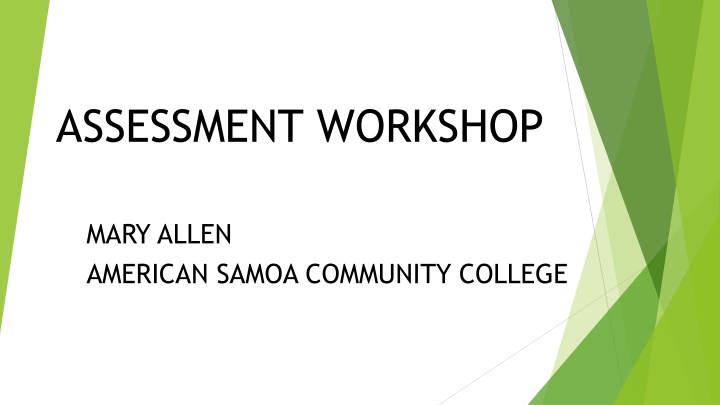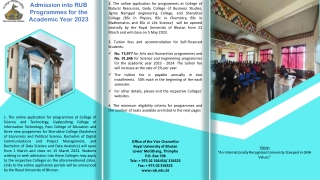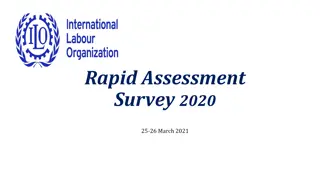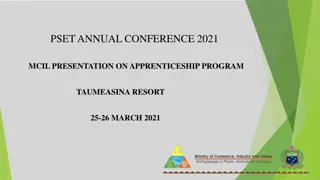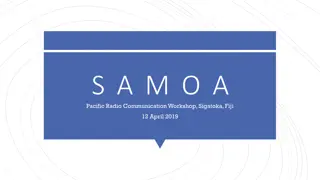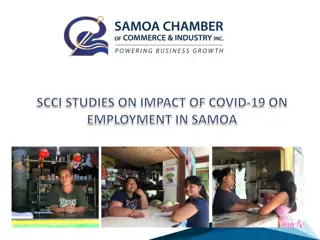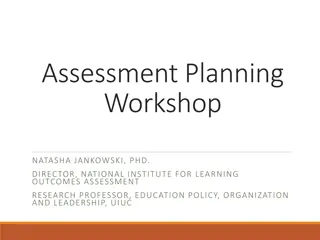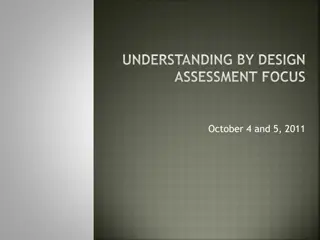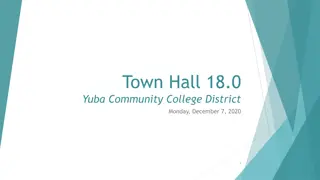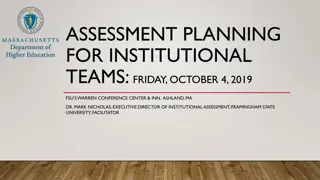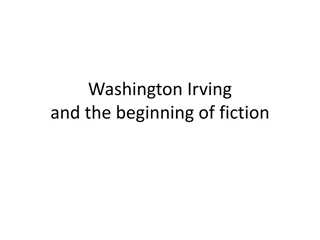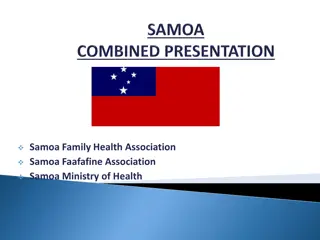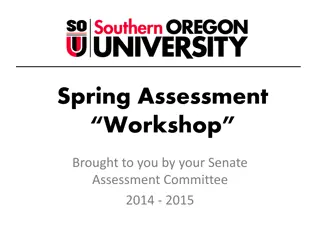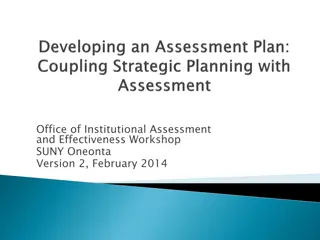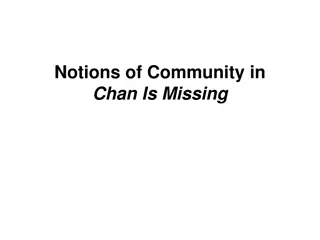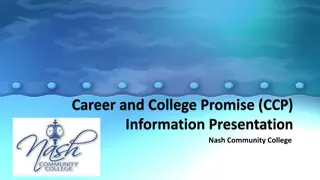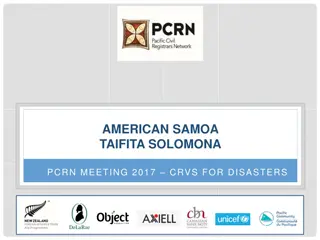Assessment Workshop at American Samoa Community College
Explore the process of assessment, including topics like rubrics, reliability, validity, data analysis, direct vs. indirect assessments, and examples of learning outcomes. Discover the strengths and methods of creating rubrics to evaluate student work effectively.
Download Presentation

Please find below an Image/Link to download the presentation.
The content on the website is provided AS IS for your information and personal use only. It may not be sold, licensed, or shared on other websites without obtaining consent from the author.If you encounter any issues during the download, it is possible that the publisher has removed the file from their server.
You are allowed to download the files provided on this website for personal or commercial use, subject to the condition that they are used lawfully. All files are the property of their respective owners.
The content on the website is provided AS IS for your information and personal use only. It may not be sold, licensed, or shared on other websites without obtaining consent from the author.
E N D
Presentation Transcript
ASSESSMENT WORKSHOP MARY ALLEN AMERICAN SAMOA COMMUNITY COLLEGE
Day 1 Rubrics Reliability, Validity, and Data Analysis
What is assessment? An on-going process to monitor and improve student learning Begin with SLOs (CLOs, PLOs, ILOs) Collect evidence about each SLO Assess the evidence and reach a conclusion Close the loop
Some Basic Vocabulary Direct vs. Indirect Assessment Authentic Assessment Formative vs. Summative Assessment
Our assessment plan should emphasize direct, authentic, summative assessment.
Rubrics Criteria for assessing students work Holistic vs. analytic rubrics
Rubric Strengths Define faculty expectations Complex products or behaviors can be examined efficiently. Well-trained reviewers apply the same criteria and standards. Rubrics are criterion-referenced, rather than norm-referenced.
Creating a Rubric Adapt an already-existing rubric Analytic method
Drafting the Rubric Start at the extremes Some words I find helpful
Lets draft a rubric. The Outcome The Evidence The Rubric Dimensions
Assessment rubrics can be integrated into grading.
Points are used for grading Categories are used for assessment All the scores are used to determine the grade. Only the results for the first three rows go into the assessment, and we reach a separate conclusion about each dimension.
Rubrics can: Speed up grading Clarify expectations to students Reduce student grade complaints Help faculty focus on important dimensions when providing feedback to students
Suggestions for Using Rubrics in Courses 1. Grade using rubrics 2. Integrate into lectures and activities 3. Develop a rubric with your students 4. Have students apply rubric to sample products 5. Have students provide peer feedback using a rubric 6. Have students self-assess using the rubric
Validity and Reliability Valid results are meaningful. Reliable results are consistent.
Examples A broken clock Assessment example 1 Assessment example 2
How to Achieve High Validity good evidence a good sample a good rubric reviewers who carefully apply the rubric when they assess the evidence
How to Achieve High Reliability Calibrate reviewers
Data Analysis for Rubrics Calculate the proportion of students at each rubric level Apply a standard to reach a conclusion about student achievement
Data Analysis for Objective Test Scores Get a separate score for each outcome. Set a standard, such as the percentage of students who get at least 8 out of 12 questions right. Apply the standard.
Content Analysis of Qualitative Data Goal is to hear and report what was said Stay focused on the project goals Analysis should be systematic, sequential, verifiable, and continuous Begin by identifying themes Develop a coding plan and code the data Summarize results for the themes Also code demographic information to be able to compare groups
Reporting Results Write the report with the audience in mind. Report the facts; don t get defensive or counterattack Provide occasional examples of responses. Include a unique response if it appears important. Include brief description of how the study was conducted.
Advice from Krueger & Casey Get to the point quickly. Use clear, effective writing. Provide enlightenment Use multiple reporting strategies Outline for a written report Avoid the ho-hum syndrome. Avoid making too many points.
Comments? Questions? What did you learn today?
Day 2: Authentic Assessment and Inter-Rater Reliability
Four Principles for Direct Assessment 1. Require students to perform the outcome. 2. Align the evidence with the rubric. 3. Use authentic assessment when possible. 4. Emphasize summative evidence.
Some Ways to Do Authentic Assessment 1. Fieldwork/practica/internships 2. Simulations and role plays 3. Case studies 4. Analysis of newspaper or magazine articles, artifacts, current events, etc. to apply learning to new situations 5. Essays: Task, Role, and Audience
How could you assess each of these outcomes using authentic assessment?
Signature Assignments 1.Assignment is designed to collect evidence for a specific SLO. 2.Generally, these assignments are designed to be used in multiple courses. 3.The assignment might be a homework assignment, an in-class activity, an out- of-class activity, or one or more exam questions.
Draft a signature assignment. What characteristics should this assignment have? How will you make this assignment authentic?
Draft an assignment for a course you teach that is authentic and that has the required characteristics for the writing signature assignment.
Assessing Evidence in a Group One reader/document Two independent readers/document Paired readers
Before inviting colleagues to a group reading, Collect the assessment evidence and remove identifying information. Develop and pilot test the rubric. Select exemplars of weak, medium, and strong student work.
Calibration Exercise You and your colleagues are teaching a course on rubrics and want to apply a rubric to provide feedback and assess your impact. Students submit a two-dimensional analytic rubric that assesses an outcome dealing with Leadership.
Confidentiality and Focus Names of students and their teachers have been removed. If you recognize an individual, don t score the submitted essay if it makes you uncomfortable or if you think your judgment might be influenced. We will not discuss individual students or colleagues, and anything you learn about an individual or a colleague does not leave this room.
The Leadership Outcome Students who complete our program can effectively lead groups to accomplish a task.
The Evidence Faculty observe a student-led group with six members that must complete a task in 20 minutes.
The Rubric You Will Apply Validity Clarity for Decision-Making
You will score three examples of student Leadership rubrics.
Rate each dimension separately. Don t let the first score you assign influence the second score (avoid the halo effect). Don t worry about how many scores of 1, 2, 3, or 4 you give. Let the rubric guide each judgment.
Your Task: Working only by yourself, use the criteria in the rubric to assign ratings from 1 to 4 to assess the Validity and Clarity of the three Leadership rubrics on the next page.
Look up when youre done, so I can tell when you re finished.
Ratings Summary and Discussion
Calibration Steps Orientation Everyone scores the exemplars. They are chosen to vary in quality. Reach consensus on what the ratings should be.
